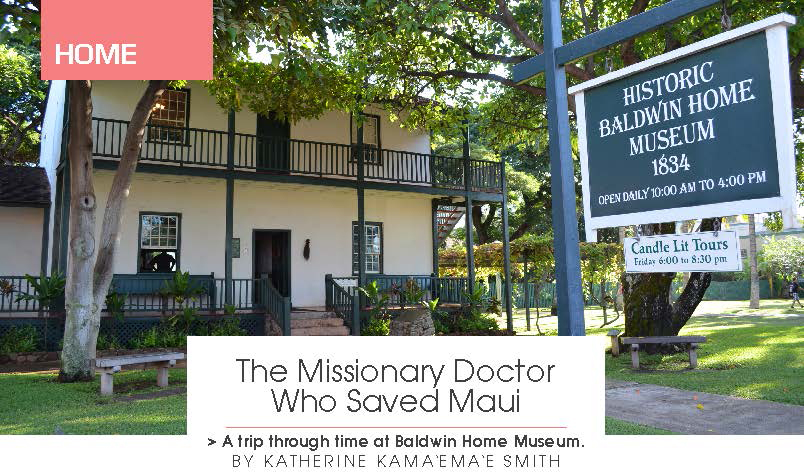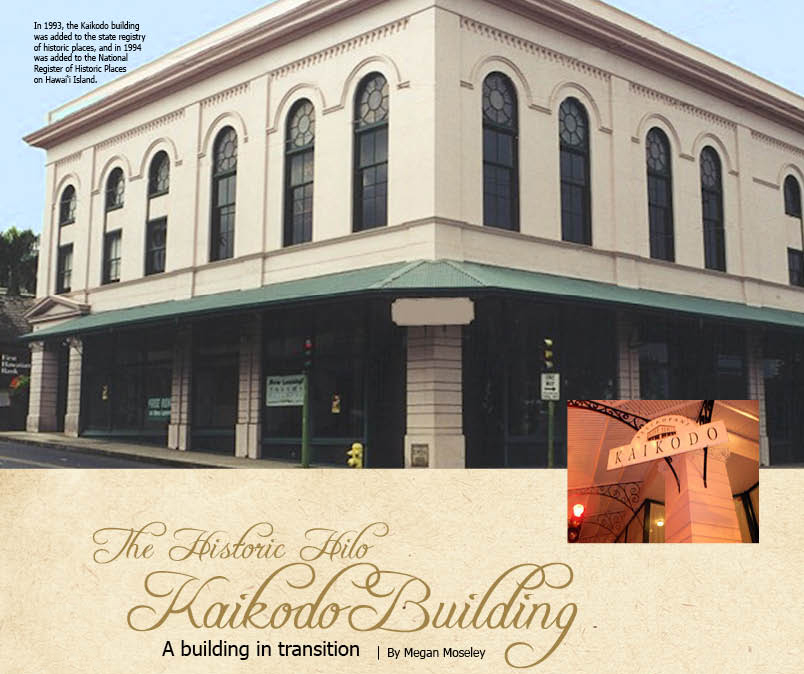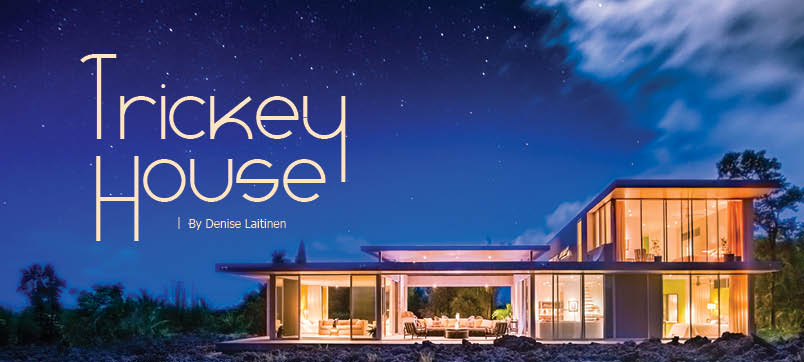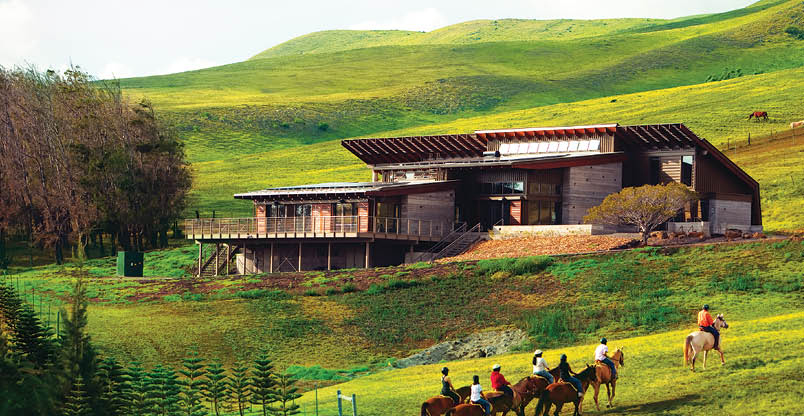
The Missionary Doctor Who Saved Maui
A trip through time at Baldwin Home Museum
 Sometimes visitors from the mainland know more about our Maui landmarks than we do. After living in Lāhainā for 23 years, passing up and down Front Street thousands of times, I decided to visit the white stucco missionary home with the big green lawn on Front Street at Dickenson—the Baldwin Home Museum.
Sometimes visitors from the mainland know more about our Maui landmarks than we do. After living in Lāhainā for 23 years, passing up and down Front Street thousands of times, I decided to visit the white stucco missionary home with the big green lawn on Front Street at Dickenson—the Baldwin Home Museum.
This building is recorded in the Historical American Buildings Survey at the Library of Congress archives.
I read online that Dr. Dwight Baldwin, who saved Maui from the small pox pandemic of 1853, lived here, but I wondered how this very old house might be connected to other buildings in Kahului named “Baldwin,” like Baldwin High School, Alexander & Baldwin Properties Inc. on Pu‘unēnē Avenue, the Alexander & Baldwin Sugar Museum on Hansen Road and the old Lāhainā pineapple cannery that used to be called Baldwin Packers Ltd.
Admission to this missionary home is $7, or $5 for seniors over 60. The fee allows you to spend as long as you like exploring two museums operated by Lahaina Restoration Foundation (LRF)—Baldwin Home Museum and Wo Hing Museum—both on Front Street, both fascinating.
A delightfully friendly and knowledgeable docent named Jackie welcomed me, showed me around and answered all my questions. Here’s what I learned:
In 1836, missionaries Dwight and Charlotte Baldwin came to Lāhainā to join the Waine‘e “station” of the American foreign mission to the Sandwich Isles (What Captain Cook “named” Hawai‘i when he rediscovered the island chain).
Reverend William Richards started the mission in Lāhainā in the 1820’s—but the thatched huts and open-air pili grass covered meeting halls he built did not survive. Even the Waine‘e Church building (now called Waiola) was destroyed by fire and rebuilt twice after windstorms, but the Baldwin stone house was still standing in 1967 when LRF restored it.
Why was Lāhainā so important to the missionaries? Well, it was the seat of government for the Hawaiian Kingdom, throne of the Kamehameha dynasty from 1830 until 1845, when King Kauikeaouli (Kamehameha III) moved the capital to Honolulu. A combination of the kingdom keeping tabs on the missionaries, and the missionaries desiring to convert the aliʻi caused the mission to be founded in Lāhainā.
Jackie explained all this history. She also showed me a hand-written document that served as Dr. Baldwin’s passport (before photography and registration numbers), his clinic and the family living quarters.
“Blue Willow” Spode china sitting on the dining table with a festive centerpiece was just as Charlotte Baldwin had described in her journal; recreated by LRF with beautiful attention to detail. Displays of Baldwin artifacts include personal effects, a flute, a concertina, medical instruments, and medications.
Oldest standing home on Maui
The Baldwin Home architecture is reminiscent of old British homes by the sea, with thick mortared walls framed in wood, and finished with lime stucco inside and out. Renovators left a small section of this structure’s two-foot thick exterior wall open—so we can see the construction—coral and lava rock chunks fitted together and cemented with sand and lime. No wonder Baldwin Home Museum is the oldest standing house in Maui County.
After Hawaiian lands went fee simple in 1848, the Baldwins purchased the compound, which stayed in their family until descendants placed it into preservation in 1964. The estate of descendant Fred Baldwin then deeded it to LRF. The organization immediately undertook the huge project of replacing termite-worn timbers, beams and framing. Under the direction of Board President Keith Tester, they returned the home to mission period condition and décor. The resulting museum reveals a ministry that spanned three important eras of Maui history: missionary times, whaling days and the sugar boom.
The Baldwin compound
Lāhainā only receives on average four days of rain per year. The rest of the time, all activities are conducted outdoors, preferably in the shade. Lāhainā was famous for the deep shade of its breadfruit trees.
The first companies of missionaries lived in small grass huts, which served mostly as storage sheds—as their Hawaiian hosts did. The high chiefs assigned a large parcel of kingdom land near the seat of government to the stewardship of the missionaries, where they could raise their families and carry out their work.
Hawaiians called such large house lots with multiple buildings “kauhale,” the equivalent of a “compound” in English. The parcel had a small stream and artesian well for fresh water, trees for shade and sufficient land to grow food and other essential plants for cordage and firewood.
In the pā (yard) today, a grand old kukui tree still lightly shades a big lawn.
During the Baldwins’ day, King Kamehameha III ruled all of Hawaiʻi from Lāhainā, and from the front windows of their home, the Baldwins were able to watch the young king working in his taro patch, now being restored on the front lawn of the Lahaina Library, which is located across the street.
It only takes a moment to “immerse” in missionary times—so compelling is the attention to detail and the mana (spiritual energy) of the Baldwin Home Museum.
The building next door—the mastersʻ reading room
I wanted to know more about Dr. Dwight Baldwin and the building next door. Who were the “Masters” it was named for?
LRF website says Missionaries William Richards and Ephraim Spaulding started construction of Lāhainā’s first stone and frame building in 1833, as an outreach ministry to whaling ships’ captains. The gentleman’s club retreat and reading room was a place where ships’ captains or “masters” could meet and record their logs.
It was built during the time when the Hawaiian High Chief Ulumāheihei Hoapili ruled as governor of Maui for the Hawaiian Kingdom. He lived near the Waine‘e mission and enforced temperance on Maui. The whaling captains preferred to bring their crews to alcohol-free Lāhainā, where they behaved better.
With contributions from the community, whaling ship officers and the American Mission, a two-story Masters’ Reading Room was completed in 1834, and it still stands on the corner of Dickenson and Front Streets.
The Home
Later in 1834, Reverend Spaulding began construction of a four-room home next to the Masters’ Reading Room. In 1836, Dwight and Charlotte Baldwin transferred to Lahaina from Waimea on Hawai‘i Island, where they had served since they came to Hawai‘i in 1831. It was the beginning of the “Great Awakening” in Hawai‘i, when thousands of Hawaiians converted to Christianity and churches began to be built throughout the islands.
Dwight and Charlotte and their children lived in a pili grass thatched hut on the compound until 1837, when Rev. Spaulding became ill and was called back to Massachusetts. Then the Baldwins moved into the stone house.
This home once had a separate kitchen house, an outhouse and a fire pit. The Baldwins farmed various crops to sustain a family of nine and mission workers. A separate kindergarten schoolhouse is now occupied by Village Galleries.
During the 31 years that they lived here, the Baldwins added two ground floor bedrooms in 1840 and a second story on the main house in 1849.
The Mission Board discontinued support of the Hawaiian mission, and Hawaiian Kingdom created a system of fee simple land transfer, allowing the Baldwins to purchase the compound.
The man who save Mauiʻs people from smallpox
Dr. Dwight Baldwin had what it took to be a missionary—a true renaissance spirit and a broad education in letters and science from Williams College and Yale. He graduated from Auburn Seminary and earned a master of science degree from Harvard Medical School. He taught school for a few years before his ordination in 1830. He immediately married Charlotte Fowler and brought her on a 10,300 nautical-mile voyage around Cape Horn to Hawai‘i, arriving in 1831.
In Waimea and in Lāhainā, Baldwin preached the gospel in Hawaiian.
As a pioneer, Baldwin was often the only person on West Maui able to administer western medicine. He used one of the four rooms in his home as a clinic, but in order to treat critically ill patients, he had to paddle a canoe, ride horseback and hike very long distances.
The Hawaiian Kingdom commissioned him as government physician for all four islands of Maui, Moloka‘i. Lāna‘i and Kaho‘olawe, but the Hawaiian Kingdom Board of Health physicians denied him a license to practice medicine.
In 1853, a pandemic of smallpox reached Honolulu from California, and eventually infected between 10 and 11 thousand people on O‘ahu. Smallpox is a highly contagious and disfiguring viral disease that spreads like colds through saliva droplets in the air and direct contact. The mortality rate is 30 percent.
While many westerners had immunity to the disease, Hawaiians did not.
Dr. Baldwin’s mainland colleagues told him about a new method to combat smallpox called vaccination and sent him inoculum. He made a complete circuit of Maui on horseback and foot, vaccinating the population. This process took several months of tireless effort. He urged Hawaiians to receive no canoes from other islands and to stone those who tried to land. He instructed communities to isolate people with symptoms of smallpox, and to burn their houses and belongings.
At the end of 1854, when the epidemic was over, only 200 Maui people died—compared to over six thousand on O‘ahu.
The Baldwin Legacy on Maui
In 1868, the Baldwins moved to Honolulu and instead of retiring, Dr. Dwight taught at O‘ahu College (now Punahou School). Charlotte passed in 1873 and Dwight lived until 1883.
Their oldest son, David Dwight Baldwin, founded the first pineapple company on Maui. The baby, Henry Perrine Baldwin, became an energetic entrepreneur, who teamed with his childhood chum, Samuel Alexander, to start a sugar plantation called Alexander & Baldwin. The company diversified into many companies, including A&B Properties on Maui.
Henry also built the Honokohau Ditch system that transports water from Honokōhau to Pu‘ukoli‘i in West Maui.
He started Honolua Ranch, a cattle business that later became a pineapple plantation under the direction of Henry’s son, Harry Baldwin, and ranch manager-botanist D. T. Fleming.
Baldwin Packers canning operations thrived in Lahaina until 1962, when the building became Lahaina Cannery Mall.
Honolua Ranch and Maui Pineapple Company morphed into Maui Land and Pineapple Company Ltd.
Harry broke ground on the current Baldwin High School building in 1940 and named it after his father, Henry Perrine Baldwin.
In 1901, Mrs. Henry Perrine Baldwin began settlement work at the Baldwin home in Lāhainā with a social worker who helped newly arrived plantation workers from Japan, the Philippines and China adjust to living on Maui. Along with other members of the Baldwin family, she continued to support the kindergarten and settlement work. The main house became a boarding house for displaced single women. Lahaina Girl Scouts held their meetings in the kindergarten room after school.
The Friday night candlelight tour of the Baldwin Home emphasizes how much Hawaiians and missionaries accomplished without electricity and modern technology. Great fortitude and energy was required to maintain order and keep families together during the upheaval of old norms and the pressures of entering the Industrial Age.
Baldwin Home Museum preserves the substantial contributions of a great Maui physician and teaches us many things we never knew before.
Lāhainā Historical Districts
The engine that keeps Lāhainā history alive and gives our community a chance to learn is Lāhainā Restoration Foundation. Executive Director Theo Morrison leads and coordinates staff, volunteers, donors, volunteers and partners, such as the County of Maui, State of Hawaiʻi and charitable foundations that support LRF projects with grant money.
A board of 25 community leaders helps oversee the 15 sites that LRF currently owns, maintains or operates in Lāhainā Historical Districts 1 and 2. It’s a huge job to ensure every site is carefully preserved and protected. Yet, the Lāhainā community values its past and there is momentum to restore a host of historical sites identified for preservation.
In the next two years, LRF will be involved in a full restoration of the makai harbor front area, including Banyan Tree Park walkways and the taro patch on the Front Street side of Lahaina Library.
In addition to preservation, Lahaina Restoration Foundation also supports many educational projects and events.
Admission to Baldwin Home Museum is $7, or $5 for seniors over 60. The fee allows you to spend as long as you like exploring two museums operated by Lahaina Restoration Foundation (LRF)—Baldwin Home Museum and Wo Hing Museum—both on Front Street. 808.661.3262


